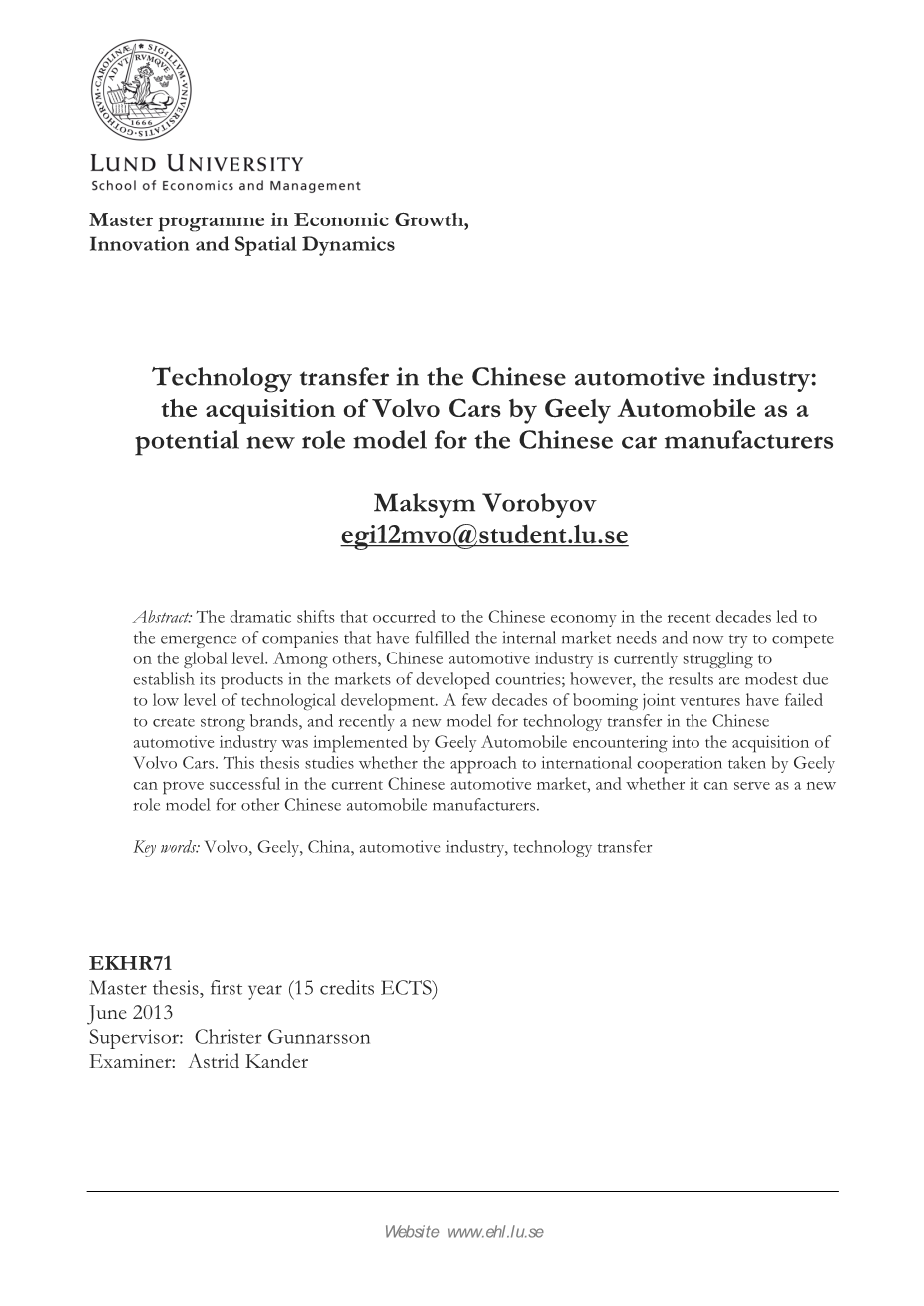

英语原文共 56 页,剩余内容已隐藏,支付完成后下载完整资料
Table of contents(原文选段)
1. Introduction................................................................................................................... 4
2. Data and methods.......................................................................................................... 7
3. Previous studies and theoretical background................................................................ 8
3.1. Strategic analysis ....................................................................................................... 16
4. Global automotive Mamp;A market with a focus on China .............................................. 32
5. Financial analysis ......................................................................................................... 35
6. Conclusions.....................................................................................................................48
1. Introduction
Half a century ago China was a country whose exports consisted mainly of food, raw
materials and textiles, with over 80% of population living behind the poverty line. Goods that
required up-to-date technologies to produce them were mainly imported from the developed
countries. The impressive changes initiated in the 1970s led to a dramatic shift in its
economy, allowing China to raise the companies that filled the internal market needs,
substituted a significant part of imports, and increased exports to become the largest exporter
in the world. On the verge of the new millennium the aim has moved further: after filling the
domestic market needs, the Chinese companies now start their expansion to Europe, USA and
other parts of the developed world. Money is in abundance due to wise fiscal policies, but the
restraining factor is the lack of modern technologies and low brand awareness. On the other
side of the globe, the leading Western companies have those qualities, but struggle because of
fierce competition in the developed markets, especially in times of recent economic
slowdown, and thus strive to settle themselves on the Chinese market which shows
unprecedented rates of growth with respect to its size.
Among all sectors of the economy, automotive industry attracts a lot of attention as an
important driver of growth, income, employment, and innovation. Since early 1990s Chinese
automotive market entered the stage of rapid development, making the world witness multiple
examples of cooperation between European and US car manufacturers with local Chinese
companies. However, those were mostly in lower market segments and were using outdated
technologies. This strategy granted its benefits to the Chinese manufacturers who were able to
fill the internal market with cheap vehicles, as well as to world giants who got access to what
recently became the largest automobile market in the world. Meanwhile, as the internal
market saturation rose, Chinese car manufacturers set their eyes on the rest of the world. The
expansion started with other developing countries like Algeria and Russia, where outdated but
cheap vehicles were in demand. In 2000s, when the Chinese automotive industry became
mature enough to compete on the markets of developing countries, Chinese manufacturers set
the new goal on Europe and Northern America. However, such obstacles as outdated
technologies and absence of recognizable brands have prevented them from successful
external expansion yet.
After two decades of booming joint ventures a new strategy of business development was first
suggested by Shanghai Automotive Industry Corporation (SAIC), which in late 2002 paid
$59.7 million to buy a 10 percent stake of GMs venture in South Korea, GM Daewoo
Automotive amp; Technologies. It was the first acquisition of an overseas automaker by a
Chinese company. Two years later SAIC acquired 48.9% of the 4th largest Korean car
manufacturer SsangYong for about $500 million in October 2004 (China Daily 2004). Shortly
after that Nanjing Automobile Corporation (NAC) followed the example and bought property
rights on some models of British company MG Rover for $104 million in December 2004
(The Auto Channel 2005). Despite optimistic prognoses, all three acquisitions failed to bring
any significant benefits neither to the purchasers, nor to the aims. Both SsangYong and Rover
filed for bankruptcy in the subsequent years, while Daewoo was later sold to Indian company
Tata Motors.
Due to the turbulence that hit financial markets in 2008, also deteriorating global car sales, the
next attempt to put the concept of technology transfer in practice was made only in 2010, but
this time the level of the deal was significantly higher. Ford Motor Company which bought
Volvo Cars (hereinafter referred as Volvo) in 2000 for $6.45 billion, with the approval of the
Swedish government agreed to sell it to Chinese company Geely Automobile (hereinafter
referred as Geely) for $1.8 billion. The deal was historical for China in many aspects. It was
the first overseas acquisition by a Chinese automobile manufacturer valued at over $1 billion;
the first acquisition of 100% stake in a foreign car manufacturer; the first acquisition of a
world-recognized automotive company by a Chinese investor. The exceptional importance of
the purchase for China was also supported by the fact that in April 2012 Chinese Prime
Minister Wen Jiabao has personally visited Volvo assembly plant in Gothenburg (Volvo Cars
2012), while Chinese Vice President Xi Jinping visited Stockholm during the negotiation
process between Ford, Geely and the Swedish government back in 2010 (Reuters 2010). The
goals and prospects were set high: at t
剩余内容已隐藏,支付完成后下载完整资料
资料编号:[147201],资料为PDF文档或Word文档,PDF文档可免费转换为Word


